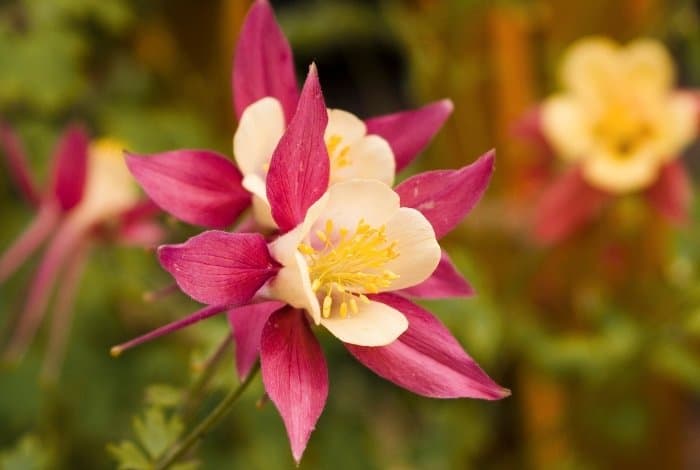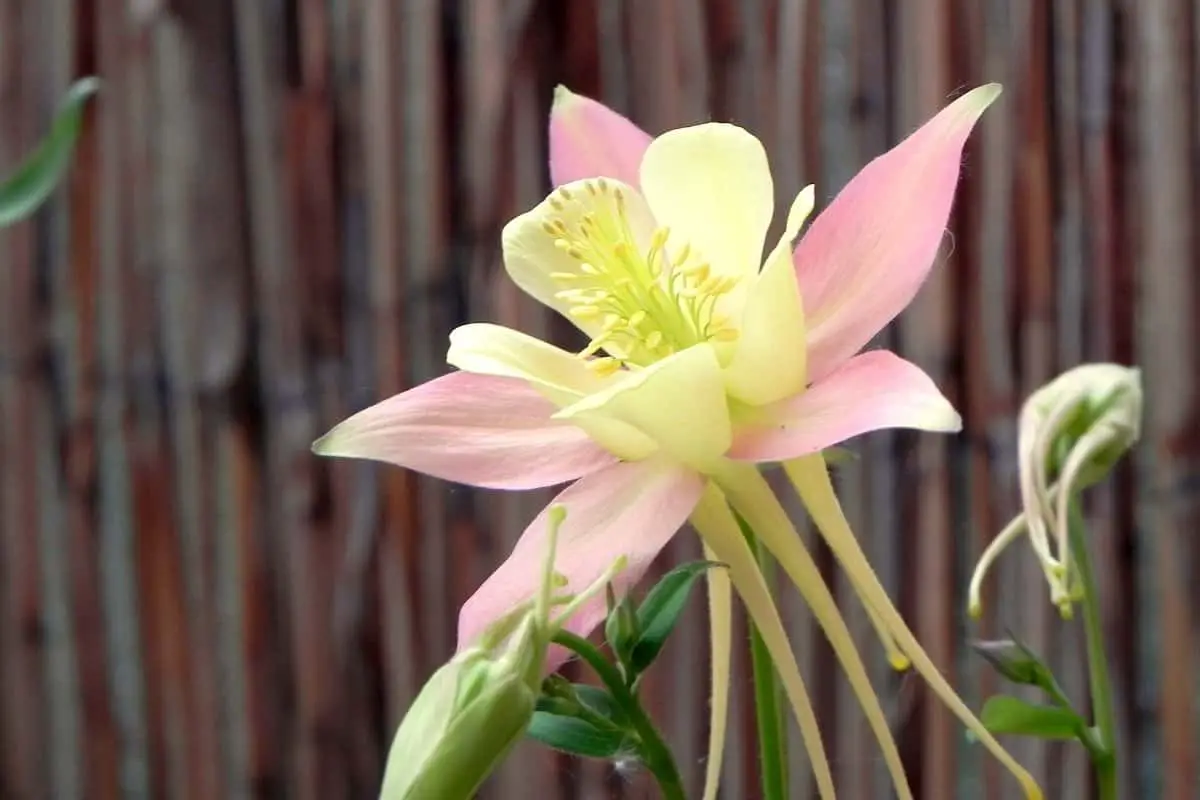Last Updated on January 4, 2022 by
Growing columbine in containers helps you manage the care for these delicate yet hardy perennials that are outstanding in beauty.
Are you looking for a beautiful yet hardy flower to add to your garden? Trust us, your search is over! Columbine is a lovely woodland plant thriving in partial sun or dappled shade areas. It originates from the genus Aquilegia that has about 100 species and cultivars. Common names for this flower are Granny’s Bonnet and the actual botanical name, Aquilegia.
Columbine plants are popular due to their bell-shaped, spurred flowers. These flowers come in a wide range of colors from bright reds, muted pastels, purples, and bi-colors. They can grow up to the height of 15 to 20 inches tall. These plants are low maintenance and add a dash of color when planted indoors or outdoors. They are loved by hummingbirds who feed on their nectar.
Columbines bloom in late spring to early summer. You can plant them in containers in late winter as a head start for its growth journey.
Growing Columbine In Containers
There are a few important steps you will need to follow.
- Purchase and Sow Seeds. You can buy columbine seeds from your local nursery or garden supply center. Plant a few seeds in each pot and lightly cover them with good soil to ensure excellent soil to seed contact. Do not plant your seeds too deep as they will not germinate. Columbines have a long taproot that needs to be transplanted to bigger pots after they germinate.
- Provide the Right Conditions for Germination. The seeds need to be kept moist so water them frequently. Keep the pots in a window that gets sunlight and shade. Do not place them facing a window where the sunlight is strongest. Germination will happen between 20 days to a month.
- Transplanting Columbines. When the columbine flowers are several inches high, transplant them. Plant each flower in a medium-sized container. Or you can group several of them in a container if it’s large enough to hold them. Space them between 14-18 inches apart. Choose the containers you want – plastic, clay, wood, or stone that complements your plants. The containers must have drainage holes at the bottom. If they don’t have to drill some holes and place a ceramic plate under them to collect the drained water. Fill each container with good quality potting soil that is well-drained. Remove the small columbines from the nursery and place it in the middle of the container where it spreads the roots for better growth.
Do you want to know if Can you Keep a Jasmine Plant Indoors?
Caring For Columbines In Containers
Growing columbine in containers allows you to water the plants with ease. Water until it drains and collects in the ceramic plates. Mulch if you wish to help retain moisture in the soil. You can also mulch to keep the roots cool and enhance the look of your container. Do not place them in direct sunlight rather keep the containers in a shaded patio or near a window that filters the sunlight. Feed the new plants with liquid fertilizer twice during the growing season for healthy roots and flowers.
Ogrmar 5PCS Gallon Durable Nursery Pot/Garden Planter Pots/Nursery Plant Container
Is Columbine Flower Toxic?
Columbine is classified as having minor toxicity and associated with gastrointestinal symptoms like vomiting and diarrhea. Therefore, it should not be ingested. Animals should also not be allowed to ingest columbine because they can experience distress, coma, behavioral changes, or even death.
Check Out if Is Christmas Cactus Poisonous for Cats?
Types of Columbine Flowers
Aquilegia ‘McKana Hybrid’: It features bi-colored flowers with long spurs in shades of red and yellow, blue and white, and pink and purple. They grow tall up to 30 inches long.
Aquilegia flabellata ‘Nana’: This dwarf cultivar has light blue and white bi-colored flowers that are 6-9 inches tall.
Aquilegia caerulea: This variety is a rocky mountain columbine that has grayish-green, fern-like foliage. It produces very large white flowers with violet-blue sepals with yellow stamens and grows up to 24 inches tall.
Aquilegia ‘Crimson Star’: This type features crimson red and white bi-colored flowers with long spurs. They can grow up to 24 -30 inches.
Aquilegia vulgaris ‘Clementine Salmon-Rose’: This long-blooming variety with salmon color produces upward-facing blooms. These blooms resemble the blossoms of double-flowered clematis. They grow 14-16 inches tall.

Common Pests That Affect Columbine Flowers
Columbine foliage is attacked by leaf miners, but the damage is not too serious. It gives the foliage a variegated look with their doodling. Leaf miners are easy to control and eliminate their doodling too. Inspect the columbine leaves and crush the larvae with your fingers. Besides the leaf miners, columbine has very few projects to deal with.
If you notice any other pest problem in your flowerbeds, use organic pesticide to resolve the issues. Neem oil is also an excellent choice that you can use. Bugs can’t stand the taste or smell of Neem, they will therefore stay away.
FAQs
How do you get columbines to grow?
The columbines are one of the easiest plants to grow. They will thrive if you keep them well watered. If there is not enough water, you can get columbines to bloom again if you take the plant out of the ground and soak it in water for about two days. Columbo flowers are really easy to care for and they will last for years if you just remember these few easy steps and to consider the following.
Columbines can grow well in a wide variety of conditions.
Water: Columbines need a well-drained soil to grow. They don't like to be over watered, but they require regular watering.
Seeding: Columbines can be planted from seed or cuttings.
Sunlight: Columbines need at least six hours of sunlight per day and should be positioned in a place that gets this amount of sunlight.
Fertilizers: Columbines need fertilizers with low nitrogen levels because they are prone to leaf burn if the nitrogen content is too high.
How do you keep columbines blooming?
Below are the methods that work quite well when you're trying to keep your Columbine blooming for as long as possible:
-Cut back the stems of the flowers when they are in full bloom so that they don't flower again in the same season. This also gives more room for new flowers to grow.
-Use a mixture of compost, peat moss, and mulch for soil. This ensures that there is adequate nutrients present so that the plant can grow well.
-Water them regularly, but not too often because columbines don't like it too wet or too dry soil conditions.
Do columbines spread?
Columbines are an important part of the garden. They are one of the very few plants that provide both height and color. Columbine plants are often used in flower arrangements, they attract butterflies and hummingbirds, but they have a tendency to spread.
They are generally not very invasive, and do not spread quickly.
Columbines are tough perennials that are hard to kill because they grow from little pieces of root that stay underground after being pulled up or dug out. Columbines can start spreading without warning, so it is important to keep an eye on their growth patterns for signs of spreading before they start taking over your entire garden space with unwanted plants.
Shortly after the flowers bloom, the columbine plant produces between 12 to 20 seeds that can be dispersed by wind or animals up to a mile away from the parent plant. Columbines also produce a long tap root that sends out lateral roots up to 10 feet from main root and these can produce new plants as well.
Caroline is a gardener who loves to get down to the nitty–gritty of gardening. She proudly proclaims herself as a ‘dirt worshipper‘ and can often be found deep in the garden, covered in soil and singing to her plants. As a self–proclaimed ‘plant whisperer‘, Caroline believes that plants need love and attention just like any other living thing, and she loves to give them both. When she‘s not tending to her garden, you can often find her researching the latest gardening trends, or teaching others how to make their gardens thrive



